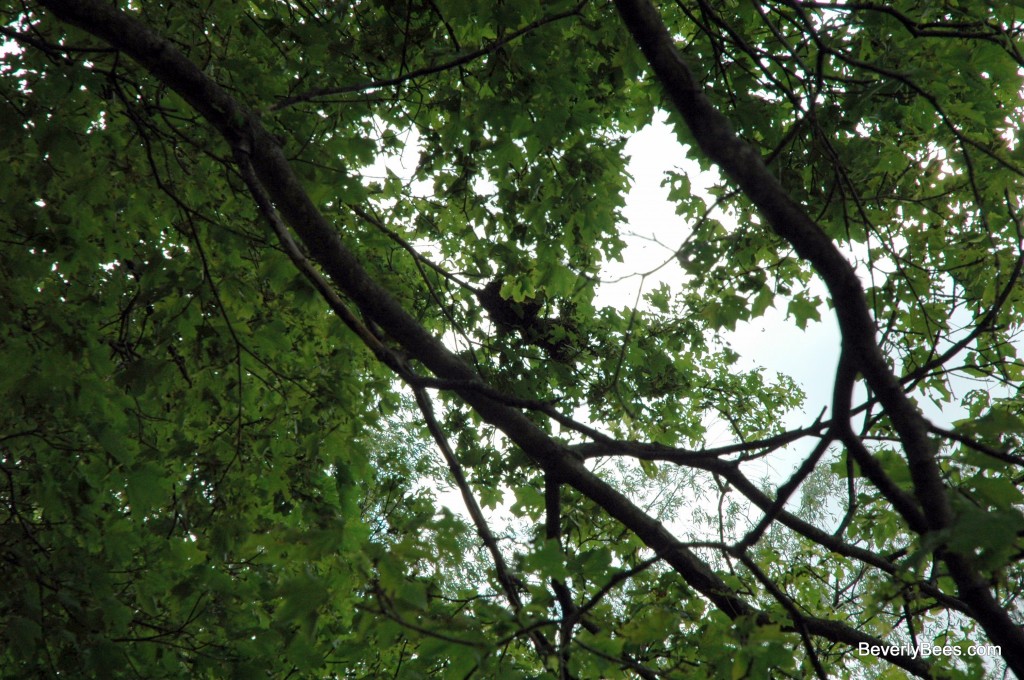Yes, sometimes bees are really stupid.
On June 10th, 2011 after several attempts my bees swarmed. Being 80 feet high in the air, I had given up on retrieving them and waved goodbye. But on June 11th, 2011, when I found out they were still there, it was raining outside, and rain was forecast for the next several days (stupid bees), I realized this would be my chance to get them back. Bees and water do not mix and wet bees cannot fly without drying off first. It was in the mid-fifties and drizzling to pouring rain all day long. This meant my bees would be one big wet mass, clinging to life on that tree branch, for a very long time.
I enlisted the help of my husband, Brian. He first tried to get the bees down by duct taping a baseball to a hot pink string and throwing it into the air, as high as he could, to try to get it wrapped around the branch the bees were clustered on. After losing four baseballs and lots of pink string in the tree, he gave up.

We then called in help from the uncles, one of whom is a painter and has very tall ladders. They came over with their 40 foot ladder and a chainsaw on a pole. We thought for sure we would be able to reach the cluster that way, but nope, the bees were still too high up. They went home and returned with the tallest ladder they had, but that ladder and a chainsaw on a pole, still could not reach the bees. While they were setting their ladder up the uncles noticed the baseballs hanging from hot pink string in the tree and asked “What the hell is that?” Upon hearing the answer, they complimented my husband on his great throwing ability and a firestorm was lit inside him.
Brian was now determined to retrieve the bees that way. He went out and bought new string, since the pink string was all stuck to baseballs in the tree, and he switched from using baseballs to rocks (after all they are much less expensive). He duct taped a rock to a string and threw it as high as he could. Still he could not get it anywhere near that branch. Persistence and determination pays off sometimes, and 4 hours of throwing later, my tired husband finally threw the rock and the string around the branch just to the left of bee cluster. We had them now.
I suited up in my bee spacesuit and helped out alongside my husband. He was tying a Cat 5 cable to the string. He used the string to pull the stronger cable around the branch. Brian then tied off the cable so we would not lose the branch. I grabbed a tarp and a bucket and laid the tarp on the ground under the bees. Next I stood under the tree and placed the bucket where I thought the bees would fall. I gave the signal and Brian shook the branch as hard as he could. Now it was raining bees right down on top of me.
They fell in big wet clumps clustered together, ranging from the size of a baseball to the size of quarter. Thousands of bees rained down onto my head, all the while I was thinking it was pretty stupid to be standing underneath that branch, but thankfully most of the bees fell in the bucket or on the tarp and not on me. Together we pulled up the corners of the tarp, scooped up the bees and dumped them into the bucket. Then we closed the lid and watched.
We were looking to see if the bees would fan to indicate the queen was there. Fanning, also sometimes called the “come hither” pose, is when the bees stick their butts in the air and let out a pheromone which communicates to the other bees to come towards them. They do this to tell their sister bees where the queen is located. When the bees did not do this, we knew we still needed to find the queen. So in the rain, we ran around and scooped up as many bee clusters on the ground as we could and placed them in the bucket. But there was still no sign of the queen. It was then, while looking toward the sky, we realized a small number of bees were still clustered on the branch. We would have to make it rain bees again.
I set out the tarp once more. But this time I stood away from the branch, instead of underneath it, then Brian shook it with all his might. To our dismay, not one bee came raining down. Instead the bees flew into the air and landed on the branch again. All the wet bees had fallen already, all that was left on that branch was the center of the cluster, which was dry, and that was where the queen would be found.
At this point, we realized the branch would have to come down. Luckily, it was a small branch. Brian thought he could break it by pulling on the cable. He pulled and pulled and pulled and finally a satisfying “Snap” was heard. The branch came tumbling down but didn’t hit the ground. Instead, it got stuck on another branch about 25 feet high, but after 80 feet this seemed like nothing.
We setup a ladder, got out the pole saw and cut the second branch close to the bees. Viola! The branch was down! We captured the swarm! I snipped the branch around the cluster and placed it in a box. Now all I had to do was rehive these bees, at least I thought.
To find out how I rehived the bees click here to read Part 3.
